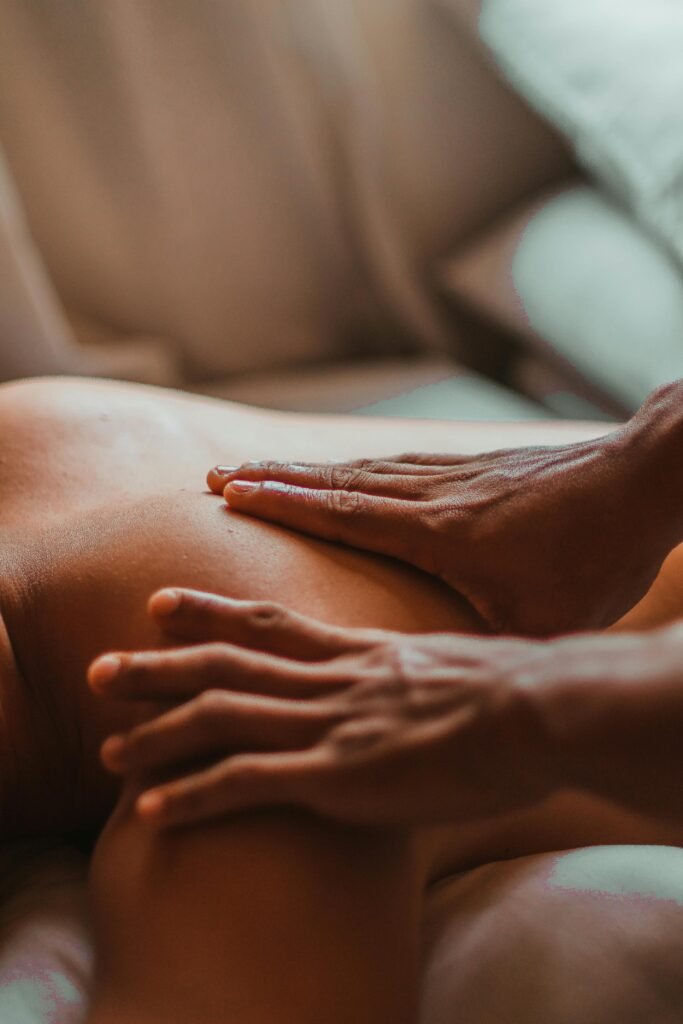Massage therapy is a holistic healing practice that has been used for centuries to promote physical and mental well-being. This post will explore what massage therapy is, the science behind how it works and the various techniques used to treat a wide range of conditions. Learn how massage can help reduce stress, alleviate pain, and improve overall health.

Introduction to Massage Therapy
Massage therapy is a hands-on technique designed to manipulate the muscles, tissues and joints to enhance physical and emotional health. It is one of the oldest forms of healthcare, with its roots having been traced back thousands of years, to ancient cultures in Egypt, Greece, India and China.
Today, it is recognised as both a complementary and alternative therapy, widely used in clinical settings and wellness practices.

What Is Massage Therapy?
Massage therapy is the practice of applying structured pressure to the soft tissues of the body, including muscles, tendons, ligaments and skin. The goal is to relieve tension, improve circulation and to help the body achieve a state of relaxation and healing. This can range from light touch to deeper, more intense pressure, depending on the type of massage and the individual’s needs.
There are many types of massage, each with its own specific techniques and benefits. Whether you are seeking relief from chronic pain, stress reduction, or simply want to find a way to unwind, there is a massage style to meet your needs.
How Does Massage Therapy Work?
Massage therapy works through a combination of mechanical and physiological processes. These work together to promote healing, reduce muscle tension and enhance overall well-being.
1. Increased Blood Circulation
One of the primary ways massage therapy works is by boosting blood circulation. The pressure applied during a massage stimulates the blood vessels, helping to increase the flow of oxygen-rich blood to muscles and tissues. This enhanced circulation contributes towards the removal of waste products like lactic acid, which builds up in muscles after exertion and causes soreness.
2. Relaxation of Muscles and Release of Tension
Massage techniques work to physically manipulate muscles, breaking up knots or adhesion in the muscle fibre. These knots form when the body experiences stress, injury, or repetitive movements. By releasing this tension massage therapy helps to restore flexibility and the range of motion in muscles and joints.
3. Stimulation of the Nervous System
The touch of a massage therapist directly influences the body’s nervous system, particularly through the parasympathetic nervous system, responsible for relaxation. This can lead to a decrease in heart rate, lower blood pressure and reduced stress hormone levels, promoting a sense of calm and relaxation.
4. Triggering the Release of Endorphins
Massage therapy also stimulates the release of endorphins which are the body’s natural painkillers and “feel-good” hormones. This helps to alleviate pain and promotes an overall sense of well-being. This is why many people feel relaxed and rejuvenated after a massage.
Types of Massage Therapy
There are various types of massage therapies, each offering unique benefits and targeting specific health concerns. Below are some of the most popular massage techniques:
Swedish Massage
Swedish massage is one of the most common forms of massage. It involves gentle, flowing strokes, kneading and circular movements on the upper most layers of muscles. This technique is ideal for relaxation, stress relief and for improving circulation. Swedish massage is often recommended for individuals new to massage therapy.
Deep Tissue Massage
Deep tissue massage is a more intense form of therapy, designed to target deeper layers of muscle and connective tissue. It is especially useful for treating chronic pain, muscle tension and injuries. The therapist applies slow, deliberate strokes to break up knots and relieve tight muscles.
Sports Massage
Sports massage is tailored to the needs of athletes or individuals involved in regular physical activity. This type of massage focuses on preventing and treating injuries, improving flexibility and enhancing performance. It often combines techniques from Swedish and deep tissue massage, along with stretches and other therapeutic methods.
Trigger Point Therapy
Trigger point therapy targets specific areas of muscle tightness that are created by pain in other parts of the body. For example, a trigger point in the shoulder may cause pain in the neck or head. This technique applies focused pressure on these “knots” to release tension and relieve discomfort.
Hot Stone Massage
Hot stone massage involves the use of heated stones placed on specific points of the body to relax muscles and increase circulation. The therapist may also use the stones to massage the body, adding a soothing, warming element to the experience. This type of massage is ideal for reducing stress and anxiety.
Reflexology
Reflexology is a massage technique focused on the feet, hands and ears. It is based on the theory that specific points in these areas correspond to different organs and systems in the body. By applying pressure to these reflex points, reflexology aims to promote healing and balance throughout the body.
Health Benefits of Massage Therapy
Massage therapy offers a wide range of health benefits that go beyond just simple relaxation. Regular sessions can significantly improve both physical and mental well-being.
1. Stress Reduction
Massage therapy is a powerful tool for reducing stress. The physical touch helps to lower cortisol levels, the hormone responsible for stress, while promoting the production of serotonin and dopamine, which enhance mood. Regular massages can help reduce the impact of stress on the body and mind.
2. Pain Relief
Massage therapy is effective in alleviating pain, particularly in people with chronic conditions such as arthritis, fibromyalgia or back pain. By improving circulation and reducing muscle tension it helps to relieve discomfort and improve mobility.
3. Improved Sleep Quality
Massage therapy can improve sleep by promoting relaxation and reducing tension. Individuals often experience deeper and more restful sleep after receiving regular massages. This is particularly beneficial for people who suffer from insomnia or other sleep disorders.
4. Enhanced Flexibility and Range of Motion
Massage therapy helps to improve flexibility and range of motion by relaxing tight muscles and breaking up adhesion in the tissue. This is especially important for athletes, the elderly, or anyone recovering from an injury.
5. Boosted Immune System
Studies show that regular massage therapy can boost the immune system by increasing white blood cell activity. These cells play a critical role in defending the body against illness. This makes massage therapy a useful complement to overall wellness routines.

Who Can Benefit from Massage Therapy?
Massage therapy is suitable for almost everyone, but it is especially beneficial for people experiencing stress, muscle tension, chronic pain, or injury. It is also useful for athletes looking to enhance performance and recovery.
However, it is important to consult with a healthcare provider before beginning massage therapy, especially if you have underlying health conditions such as heart disease or osteoporosis.
Conclusion: mASSAGE tHERAPY
Massage therapy is a versatile and effective treatment to promote physical healing, reduces stress and enhances overall well-being. By working on the muscles, tissues and nervous system, massage therapy provides both immediate relief and long-term benefits.
Whether you are seeking relaxation, pain relief, or a way to boost your health, massage therapy offers a natural, non-invasive solution to help you feel your best.



